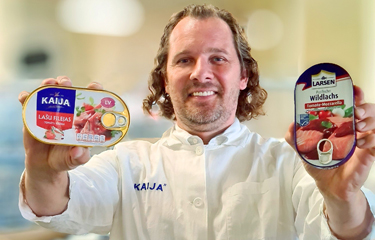Riga, Latvia-headquartered SIA Karavela has invested in a new production line for wild-caught skinless and boneless salmon products.
Karevela CEO and Co-Owner Andris Bite current production and supply systems for wild-caught canned salmon are unable to fully meet the market demand in countries where they are in high demand, including the United Kingdom, United States, Australia, New Zealand, and Canada, while his company is already using similar processing technologies to obtain products that are “very close to the original” produced in Alaska.
“I admit that there are nuances that cannot be fully extracted from frozen raw materials, but we have managed to achieve the fundamentals of this product – taste and juiciness,” Bite said.
Bite equates his salmon solution with one that was successfully introduced with smoked sprats, a specialty among Latvian producers, who used to manufacture about 200 million cans a year. In the past, standards stipulated that the highest-quality sprats should only be produced from fresh sprats, fished between September and March/April, because the industry recognized there was a difference in taste between products made from fresh and frozen ingredients, he said.
“However, today almost all premium sprats are made directly from frozen raw materials and are accepted by the consumer. So, for wild salmon, we think the same – there are things that only professionals see and understand, and there are things that are important to the end consumer,” Bite said. “Of course, an important factor is also the fact that the price of the product is customer-friendly, and it increases the availability of the product. These are also factors that affect any market.”
In parallel with product development, Karevela has been gathering and compiling information about the canned salmon segment, conducting an analysis of pricing, markets, product specifications, and regulations. While Alaska’s canned wild salmon is produced from fresh fish with a limited fishing period from July to October, the company has found that Alaskan supply chain is reliant on irregular logistics routes, which can limit the assortment and supply of raw materials. At the same time, each new year and fishing season is different with catch quotas that do not match market needs and demand, Bite said.
“Therefore, data and statistics show that consumption of this product is falling, and it is not due to a change in consumer choice but to limited supply,” Bite said. “As a result, the price of the product is rising, although there is no basis for this. This is because there is currently no demand-supply balance in the market.”
Bite said Karevela’s product specification will be “slightly different” from the Alaska product, but that its offer is based on the stability and predictability of customer supply, because it will buy raw materials from Russia as well as Alaska.
“This will allow us to be independent of any fall or rise in the season of each catch area. We will also be able to make deliveries at the customer’s request instead of buying everything in one quarter,” he said.
The company is also now working on a new category of canned wild salmon in different sauces and cans options.
“There is always a risk, but we are fully aware of it,” he said.
Karavela exported more than 73 million cans to some 45 countries in 2021. Its exports accounted for 94 percent of production in 2021, with the company benefitting from a EUR 16 million (USD 18.1 million) investment plan designed to strengthen its competitiveness.
Photo courtesy of Karavela







